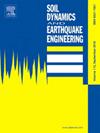采用不同损伤识别指标研究损伤位置和强度对砖砌体拱动力特性的影响
IF 4.2
2区 工程技术
Q1 ENGINEERING, GEOLOGICAL
引用次数: 0
摘要
本研究对具有波斯建筑遗产代表性的半圆形砖石膏砌筑拱门的动态行为进行了全面的、时间解决的局部损伤和随后修复的影响调查。利用增强频域分解(EFDD)和随机子空间识别(SSI)的操作模态分析(OMA),在三种不同的损伤情况下,以及修复后,评估了完整情况下的动态响应。结果表明,损伤位置和对称性对拱的动力性能有显著影响。局部损伤导致固有频率大幅降低,模式二显示初始损伤减少26.6%,最严重情况下减少43.5%。对称损伤降低了基本模态的敏感性,强调了多模态评估的必要性。与EFDD相比,平均模态阻尼比增加了107.2,提供了更一致和可靠的检测。使用传统石膏砂浆修复可以显著改善动态特性,相对于受损状态,其固有频率恢复了约13.5%的EFDD和13%的SSI。修复后24 h内模态参数稳定;然而,某些模式显示不完全恢复,特别是在传感器位置附近,表明剩余刚度缺陷。模态保证准则(MAC)、归一化模态差分(NMD)和坐标模态保证准则(COMAC)的损伤检测指标能够有效识别损伤,增强了它们在遗产结构健康监测中的重要作用。该研究强调了将恢复视为一个时间依赖的、不断发展的过程的重要性,并倡导建立综合和多参数监测框架。研究结果为优化历史砌体结构的保护策略提供了实用的见解,并为未来解决环境影响、数值模拟和先进修复材料的工作提供了建议。本文章由计算机程序翻译,如有差异,请以英文原文为准。
Effect of the location and intensity of damage on the dynamic characterisation of the brick masonry arch using different damage identification indices
This study presents a comprehensive, time-resolved investigation into the effects of localised damage and subsequent restoration on the dynamic behaviour of a semi-circular brick-and-gypsum masonry arch, representative of Persian architectural heritage. Using Operational Modal Analysis (OMA) with Enhanced Frequency Domain Decomposition (EFDD) and Stochastic Subspace Identification (SSI), dynamic responses were evaluated across intact, under three distinct damage scenarios, and following restoration. The findings reveal that both damage location and symmetry significantly influence the arch's dynamic properties. Localised damage led to substantial reductions in natural frequencies, with mode two exhibiting up to 26.6 % reduction in initial damage and 43.5 % in the most severe scenario. Symmetric damage reduced sensitivity in fundamental modes, underscoring the need for multi-modal assessment. Average modal damping ratios increased by up to 107.2 providing more consistent and reliable detection compared to EFDD. Restoration using traditional gypsum mortar significantly improved dynamic characteristics, with natural frequencies recovering by approximately 13.5 % EFDD and 13 % SSI relative to the damaged state. Modal parameters stabilised within 24 h post-restoration; however, certain modes showed incomplete recovery, especially near sensor locations indicating residual stiffness deficits. Damage detection indices of Modal Assurance Criterion (MAC), Normalised Modal Difference (NMD), and Coordinate Modal Assurance Criterion (COMAC) have effectively identified damage, reinforcing their critical role in heritage structural health monitoring. The research highlights the importance of considering restoration as a time-dependent, evolving process, and advocates for integrated and multi-parameter monitoring frameworks. The results offer practical insights for optimising the conservation strategies of historic masonry structures, with recommendations for future work addressing environmental effects, numerical modelling, and advanced restoration materials.
求助全文
通过发布文献求助,成功后即可免费获取论文全文。
去求助
来源期刊

Soil Dynamics and Earthquake Engineering
工程技术-地球科学综合
CiteScore
7.50
自引率
15.00%
发文量
446
审稿时长
8 months
期刊介绍:
The journal aims to encourage and enhance the role of mechanics and other disciplines as they relate to earthquake engineering by providing opportunities for the publication of the work of applied mathematicians, engineers and other applied scientists involved in solving problems closely related to the field of earthquake engineering and geotechnical earthquake engineering.
Emphasis is placed on new concepts and techniques, but case histories will also be published if they enhance the presentation and understanding of new technical concepts.
 求助内容:
求助内容: 应助结果提醒方式:
应助结果提醒方式:


